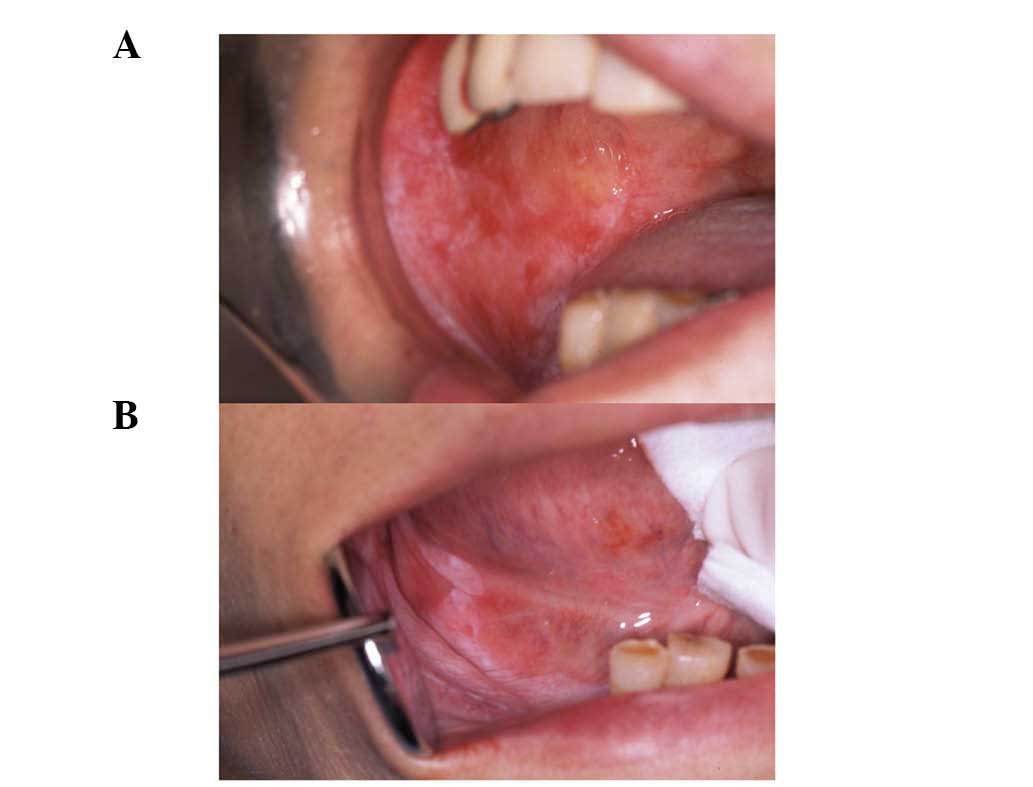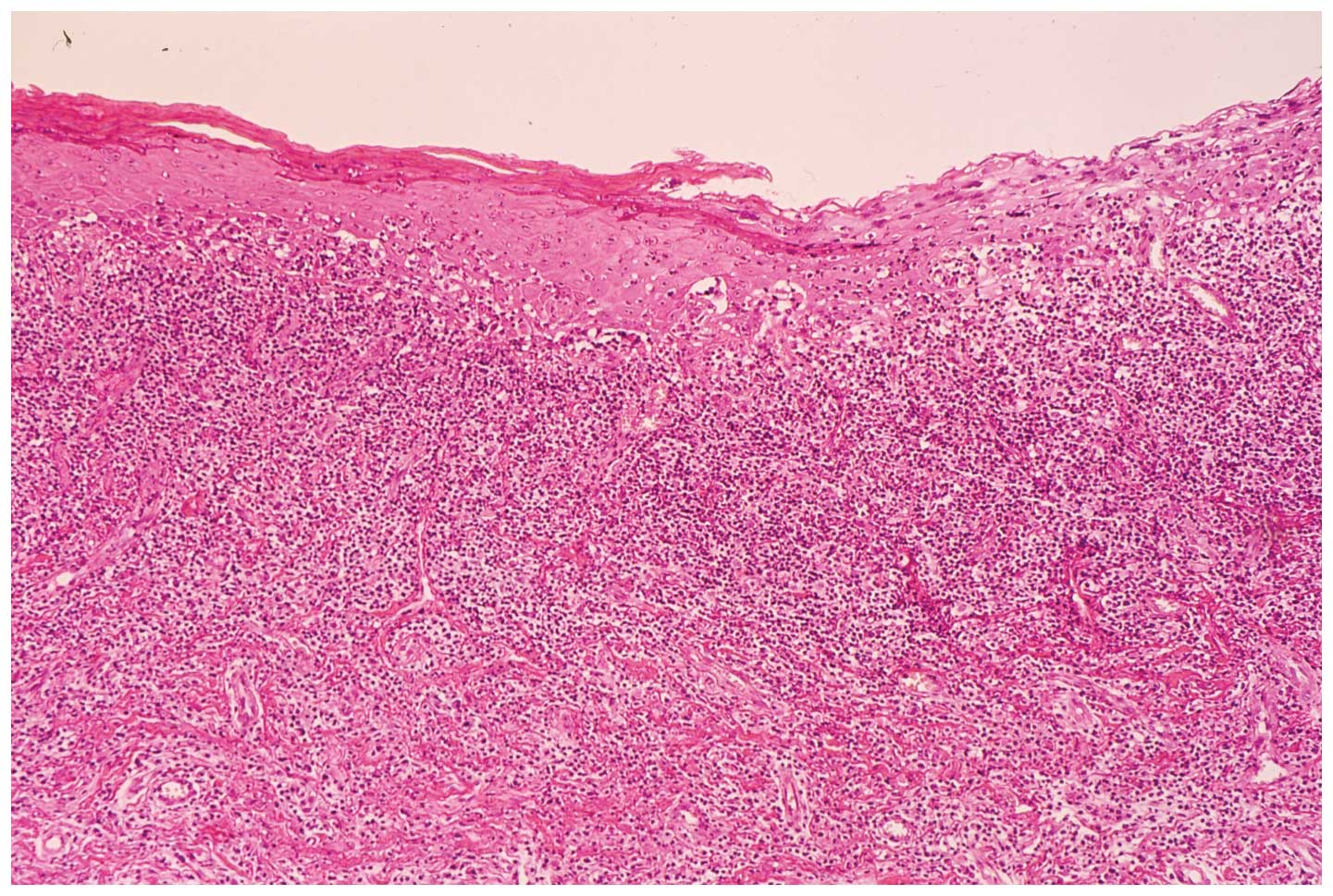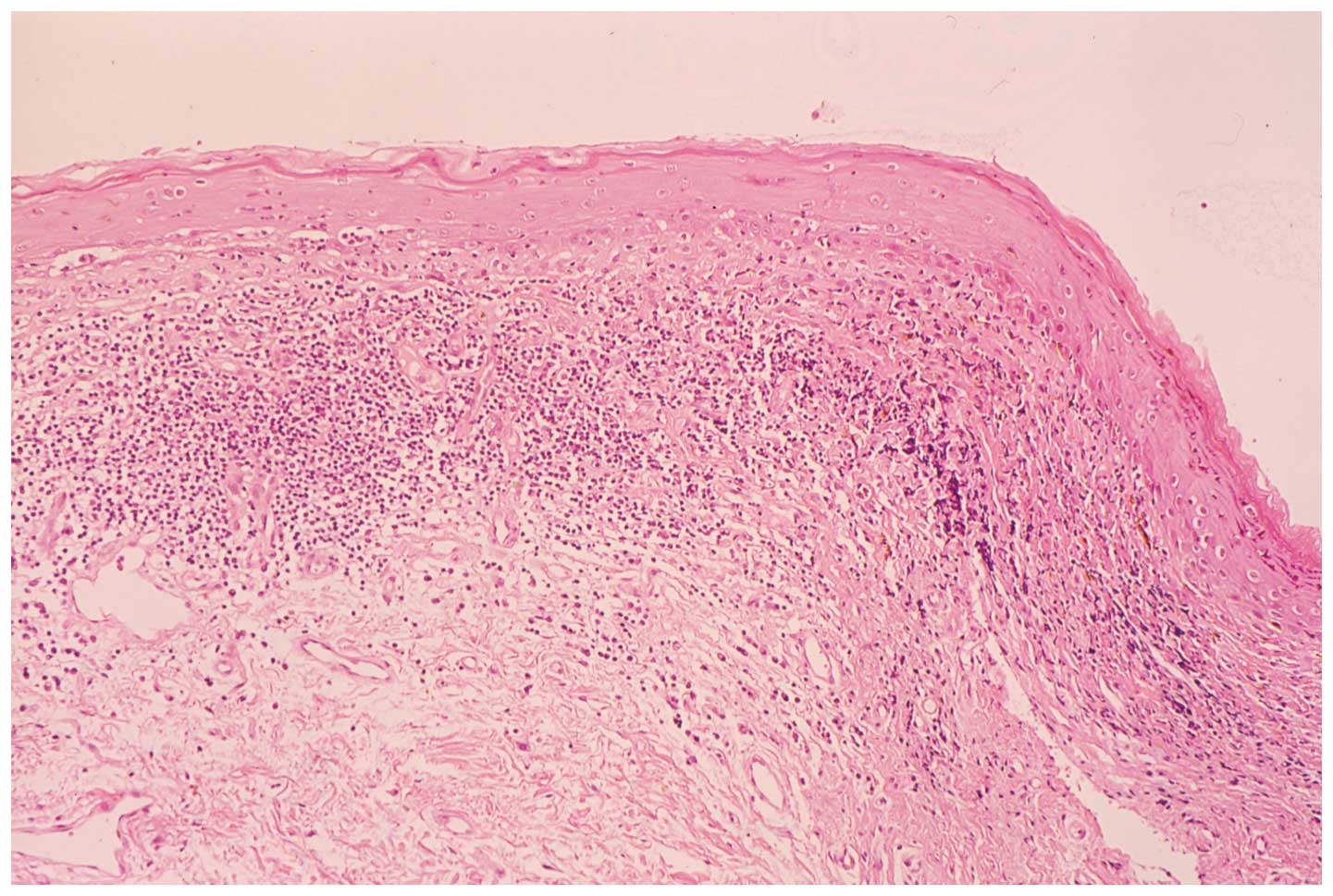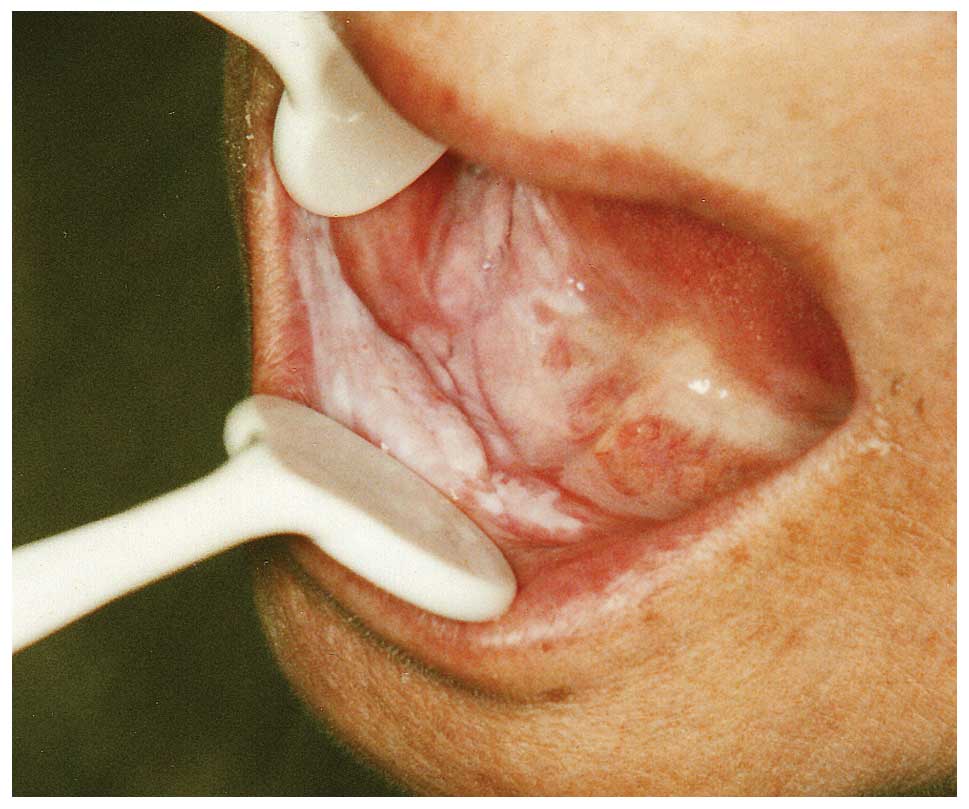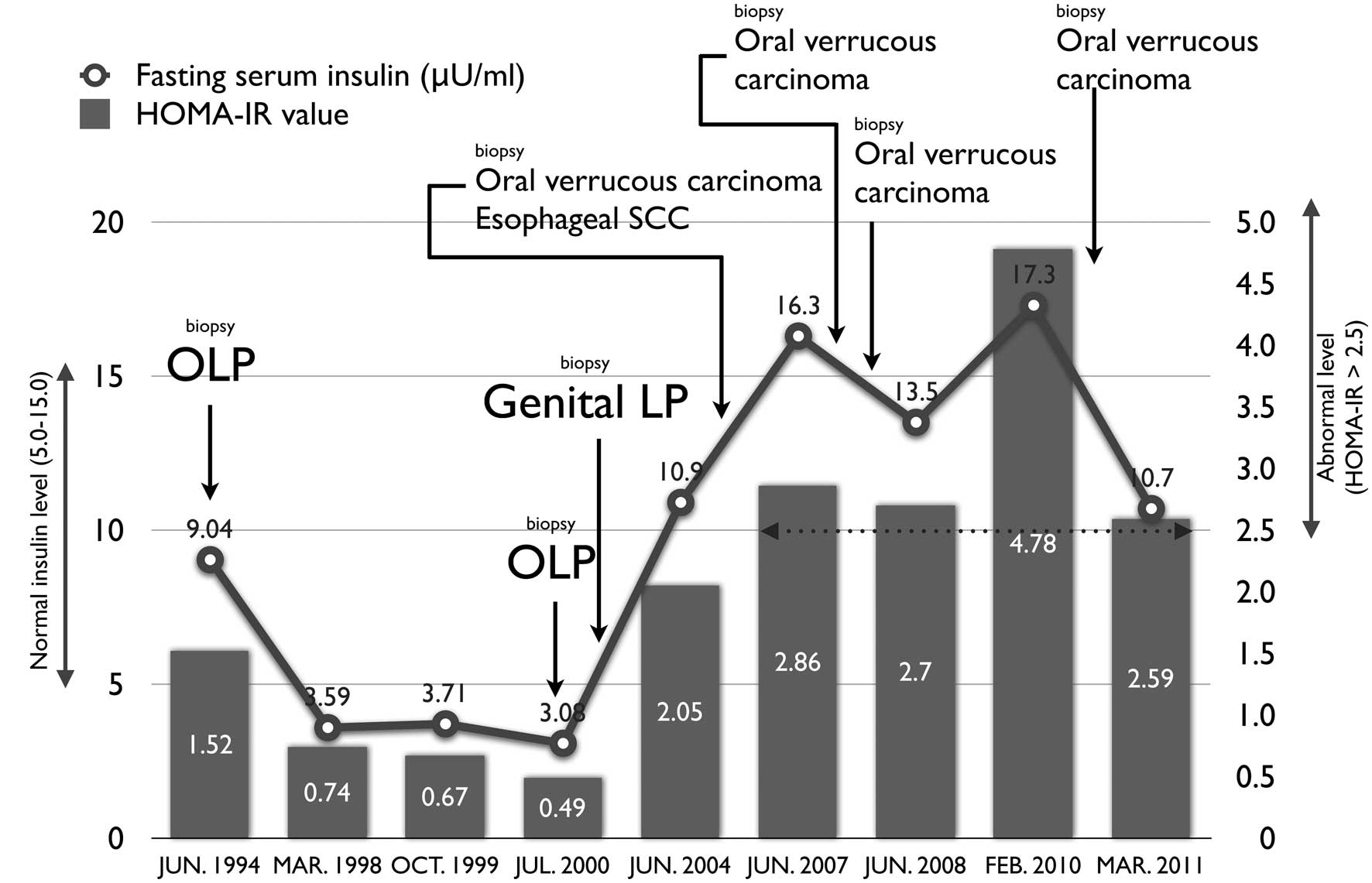Oral verrucous carcinoma arising from lichen planus and esophageal squamous cell carcinoma in a patient with hepatitis C virus-related liver cirrhosis-hyperinsulinemia and malignant transformation: A case report
- Authors:
- Published online on: October 3, 2012 https://doi.org/10.3892/br.2012.14
- Pages: 53-56
Abstract
Introduction
Oral lichen planus (OLP) is an inflammatory disorder of the skin and mucous membranes. Extraoral mucosal lesions have been reported in the esophagus, conjunctiva, bladder, nasal mucosa, larynx, pharynx, stomach, anal mucosa, vulva, vagina and penis (1,2). Some patients with OLP develop extraoral manifestations simultaneously (1). Vulvo-vaginal-gingival syndrome is a variant of mucosal lichen planus characterized by erosions and desquamation of the vulva, vagina and gingiva (3).
One of the potential complications of OLP is malignant transformation. Patients with OLP have an increased risk of developing oral squamous cell carcinomas (OSCC), which led the World Health Organization (WHO) to classify OLP as a potentially malignant disorder (4). A number of studies have reported an association between OLP and a premalignant state, with a malignant transformation rate of 0–12.5% (5–10).
Lichen planus is known to occur in patients with liver disease, particularly hepatitis C. A close association of lichen planus and hepatitis C virus (HCV) infection has been reported in Japan and certain southern European regions (11,12). In multiple meta-analyses, patients with lichen planus have an ∼5-fold higher risk, compared to the controls, of being HCV-seropositive (odds ratio: 2.5–4.5) (13–15).
An association between HCV infection and OSCC has been reported (16–19). The prevalence of HCV infection in OSCC with multiple primary carcinomas was previously reported (20). In addition, HCV infection has been found to be an independent factor in the development of multiple primary carcinomas in patients with OSCC (21).
Carrozzo et al(22) reported a case of oral verrucous carcinoma arising in a patient with OLP and HCV infection. Verrucous carcinoma is a rare type of low-grade and well-differentiated SCC, with less potential for lymph node metastasis compared to other oral carcinomas and is known to occur in the larynx, pyriform sinus, nasal cavity, skin and esophagus, the oral cavity being the most common site (23).
In this study, we present a case of synchronous oral verrucous carcinoma and esophageal SCC in a patient with HCV-related liver cirrhosis. This oral verrucous carcinoma is a malignant change arising in OLP-coexisting vulvo-vaginal-gingival syndrome.
Case report
In June 1994, a 71-year-old Japanese females presented at the Kurume University Hospital (Fukuoka, Japan) with a burning pain in the oral cavity on eating and drinking. She first experienced the pain and a burning sensation in the oral mucosa approximately 12 months before. The lesions were examined and were identified as erosive and atrophic types, affecting the bilateral buccal mucosa, mandibular alveolar mucosa, tongue, gingiva, palate, oral floor and the lower lip (Fig. 1).
Two biopsy specimens of the buccal mucosa and mandibular alveolar mucosa were characterized by hyperparakeratosis with the thickening of the granular layer, a subepithelial band of infiltration of lymphocytes and liquefied degeneration of the basal cell layer. Histopathological findings were consistent with a diagnosis of OLP (Fig. 2).
The patient was unaware of being infected with HCV until she underwent a serological examination at our hospital. The serum HCV RNA levels, quantified using the Roche Amplicor Monitor assay (Roche Diagnostic Systems, Inc., Indianapolis, IN, USA) and HCV genotype were 2200 KIU/ml and 1 b, respectively. Serum levels were negative for hepatitis B surface antigen (HBsAg). The patient underwent ultrasonographic (US) examination and computed tomography (CT). Alternative potential predictors of progression of liver cirrhosis were applied, including serum albumin, total bilirubin, prothrombin time and the platelet count. The patient was diagnosed with liver cirrhosis. On detailed examination, no systemic disease other than chronic liver disease was confirmed.
Laboratory data in 1994 were: aspartate aminotransferase 62 U/l; alanine aminotransferase 39 U/l; γ-glutamyl transpeptidase 26 U/l; total protein 7.8 g/dl; albumin 3.7 g/dl; red blood cell count 384×104/mm; white blood cell count 4400 mm; hemoglobin 11.8 g/dl; platelet count 15.9×104/mm; fasting plasma glucose 97 mg/dl; hemoglobin A1c 5.8; fasting serum insulin 9.04 μU/ml and homeostasis model assessment-insulin resistance (HOMA-IR) 4.78. Insulin resistance was evaluated using the homeostasis model assessment (HOMA-IR) method, using the formula: HOMA-IR = fasting glucose (mg/dl) × fasting insulin (μU/ml)/405.
Body mass index (BMI) of the patient was 20.93 kg/m2 (height 1.45 m, weight 44 kg). BMI was used as an index of obesity and was calculated as body weight in kilograms divided by the square of height in meters (kg/m2). No habitual alcohol drinking or smoking was confirmed. No history of blood transfusion or tattooing was confirmed, while her family history was not contributory.
Treatment was initiated with a topical corticosteroid and vitamins. Glycyrrhizin was administered daily from January 1995 by intravenous injection. Subsequently, the patient controlled the oral lesions by applying a topical corticosteroid for oral pain. We monitored her condition every 3–4 months by conducting an oral medical examination, blood tests and abdominal echography performed by an oral surgery specialist and a hepatologist.
In March 2001, although the patient did not complain of sensation in the genital mucosa, she was examined by a gynecologist to determine whether genital lichen planus was present. The physical findings comprised primarily erythema of the inner labia minora. A biopsy specimen of the vulval mucosa was characterized by a subepithelial band of infiltrating lymphocytes and liquefied degeneration of the basal cell layer (Fig. 3). The clinicopathological diagnosis of the patient was vulvo-vaginal-gingival syndrome.
In November, 2004, the 81-year-old patient underwent a routine examination of the upper gastrointestinal tract to confirm the presence or absence of esophageal varices associated with her liver cirrhosis. An erosive lesion of the esophagus was observed. In addition, we observed a red-and-white papillary and exophytic mass, 15×13 mm in diameter, in the mandibular alveolar and the right buccal mucosa and the right lower lip (Fig. 4). Ultrasonographic examination of the cervical region did not show lymph node metastasis. The pathological diagnosis was SCC of the esophagus (0-IIc, T1a) and verrucous carcinoma of the oral cavity (T1N0M0, stage I). There was no continuity between the esophageal and oral cancer. The patient underwent surgical resection of the oral verrucous carcinoma in December, 2004 and endoscopic submucosal dissection of the esophageal cancer in March, 2005.
The oral verrucous carcinoma recurred in September, 2007 and February 2008 and was resected surgically. In addition, the patient (then 87-year-old) received radiotherapy in August, 2010, subsequent to recurrence of the oral cancer. Following radiotherapy of 45 Gy, the tumor disappeared completely. The patient’s condition was considered stable, under treatment in August, 2012, two years later. Fig. 5 shows the clinical course of the patient.
Discussion
Several studies have demonstrated that carcinoma may arise from OLP (5–10). In their study, Gandolfo et al(5) reported that HCV infection increased the risk of OSCC in patients with OLP by a factor of 3.16 (95% CI, 0.80–12.5). Smoking, atrophic-erosive forms, gender and age, diet and candidiasis are factors, other than HCV infection, associated with a malignant change of OLP (7).
In this study, we have presented a case of verrucous carcinoma that developed in a patient with OLP who suffered from HCV-related liver cirrhosis, 10 years after the initial diagnosis. Simultaneously, the patient developed esophageal SCC besides oral cancer. The patient had lichen planus affecting not only the oral, but also the genital mucosa.
In their study, Sikuler et al(24) evaluated the association between HCV infection and extrahepatic malignancies. Extrahepatic malignancies were found in 14.6% of anti-HCV-positive patients. Lee et al(25) prospectively studied the risk of HCV infection on hepatic and extrahepatic deaths. Their study demonstrated significant associations between anti-HCV seropositivity and increased mortality from extrahepatic cancers with multivariate-adjusted hazard ratios of 4.08 for the esophagus, 4.19 for the prostate and 8.22 for the thyroid. Furthermore, they showed that persistent HCV infection (anti-HCV and HCV RNA seropositive) markedly increased the mortality rate caused by hepatic and extrahepatic diseases.
In the present case, the factors thought to be responsible for the development of malignant transformation are the long-lasting presence of symptomatic OLP, persistent HCV infection, advanced age and hyperinsulinemia. We reported previously that insulin resistance might be involved in the development of multiple primary cancers in patients with OSCC and HCV infection (21), and might cause OLP and extrahepatic manifestations (26,27). The prevalence of extra-hepatic malignant tumors was significantly higher in patients with OLP (29.4%), compared to patients without (4.3%). Hyperinsulinemia may induce extrahepatic malignant tumors, as well as hepatocellular carcinoma (HCC), thus high insulin levels could promote the selective growth of cancer cells (28). HCV-associated insulin resistance induces hepatic steatosis, resistance to anti-viral treatment, hepatic fibrosis and esophageal varices, hepatocarcinogenesis and proliferation of HCC, and extrahepatic manifestations (29).
The patient in this report developed carcinoma when the insulin level was high, thus we believe that this should be measured regularly in patients with HCV-associated OLP.
Lichen planus is known to develop in mucosal tissues, with the exception of the oral mucosa (1–3). Eisen (1) evaluated extraoral involvement in a large series of patients with OLP and reported that extraoral manifestations included cutaneous LP in 16% of patients (93/584) and genital LP in 19% of 399 women and 4.6% of 174 men. Previously, we showed extraoral involvement in female patients with OLP of 41.7% (10/24) vulvar and 8.3% (2/24) cutaneous LP (30). It is important for patients with OLP to be monitored for the presence of extra-oral lichen planus, such as in the genital mucous membrane and the gastrointestinal tract, since it is more likely to progress to a malignant transformation.
In conclusion, we reported a case of oral verrucous carcinoma arising from OLP-coexisting vulvo-vaginal-gingival syndrome and esophageal SCC in a patient with HCV-related liver cirrhosis. Success in the detection and treatment of multiple primary cancers at early stages requires close cooperation between various medical specialists.
Abbreviations:
|
OLP |
oral lichen planus |
|
SCC |
squamous cell carcinoma |
|
OSCC |
oral squamous cell carcinoma |
|
HCV |
hepatitis C virus |
|
HCC |
hepatocellular carcinoma |
|
anti-HCV |
HCV antibody |
|
HBsAg |
hepatitis B surface antigen |
Acknowledgements
This study was supported in part by a Grant-in-Aid for Scientific Research (C) (no. 22592354) from the Ministry of Education, Culture, Sports, Science and Technology of Japan.
References
|
Eisen D: The evaluation of cutaneous, genital, scalp, nail, esophageal, and ocular involvement in patients with oral lichen planus. Oral Surg Oral Med Oral Pathol Oral Radiol Endod. 88:431–436. 1999. View Article : Google Scholar : PubMed/NCBI | |
|
Le Cleach L and Chosidow O: Clinical practice. Lichen planus. N Engl J Med. 366:723–732. 2012. | |
|
Pelisse M, Leibowitch M, Sedel D and Hewitt J: A new vulvovaginogingival syndrome. Plurimucous erosive lichen planus. Ann Dermatol Venereol. 109:797–798. 1982.(In French). | |
|
Warnakulasuriya S, Johnson NW and van der Waal I: Nomenclature and classification of potentially malignant disorders of the oral mucosa. J Oral Pathol Med. 36:575–580. 2007. View Article : Google Scholar : PubMed/NCBI | |
|
Gandolfo S, Richiardi L, Carrozzo M, et al: Risk of oral squamous cell carcinoma in 402 patients with oral lichen planus: a follow-up study in an Italian population. Oral Oncol. 40:77–83. 2004. View Article : Google Scholar : PubMed/NCBI | |
|
Lodi G, Scully C, Carrozzo M, Griffiths M, Sugerman PB and Thongprasom K: Current controversies in oral lichen planus: report of an international consensus meeting. Part 2. Clinical management and malignant transformation. Oral Surg Oral Med Oral Pathol Oral Radiol Endod. 100:164–178. 2005. View Article : Google Scholar : PubMed/NCBI | |
|
Gonzalez-Moles MA, Scully C and Gil-Montoya JA: Oral lichen planus: controversies surrounding malignant transformation. Oral Dis. 14:229–243. 2008. View Article : Google Scholar | |
|
Bermejo-Fenoll A, Sánchez-Siles M, López-Jornet P, Camacho-Alonso F and Salazar-Sánchez N: A retrospective clinicopathological study of 550 patients with oral lichen planus in south-eastern Spain. J Oral Pathol Med. 39:491–496. 2010. View Article : Google Scholar : PubMed/NCBI | |
|
Warnakulasuriya S, Kovacevic T, Madden P, Coupland VH, Sperandio M, Odell E and Møller H: Factors predicting malignant transformation in oral potentially malignant disorders among patients accrued over a 10-year period in South East England. J Oral Pathol Med. 40:677–683. 2011. | |
|
Bombeccari GP, Guzzi G, Tettamanti M, Giannì AB, Baj A, Pallotti F and Spadari F: Oral lichen planus and malignant transformation: a longitudinal cohort study. Oral Surg Oral Med Oral Pathol Oral Radiol Endod. 112:328–334. 2011. View Article : Google Scholar : PubMed/NCBI | |
|
Nagao Y, Sata M, Tanikawa K, Itoh K and Kameyama T: Lichen planus and hepatitis C virus in the northern Kyushu region of Japan. Eur J Clin Invest. 25:910–914. 1995. View Article : Google Scholar : PubMed/NCBI | |
|
Lodi G, Giuliani M, Majorana A, Sardella A, Bez C, Demarosi F and Carrassi A: Lichen planus and hepatitis C virus: a multicentre study of patients with oral lesions and a systematic review. Br J Dermatol. 151:1172–1181. 2004. View Article : Google Scholar : PubMed/NCBI | |
|
Shengyuan L, Songpo Y, Wen W, Wenjing T, Haitao Z and Binyou W: Hepatitis C virus and lichen planus: a reciprocal association determined by a meta-analysis. Arch Dermatol. 145:1040–1047. 2009.PubMed/NCBI | |
|
Lodi G, Pellicano R and Carrozzo M: Hepatitis C virus infection and lichen planus: a systematic review with meta-analysis. Oral Dis. 16:601–612. 2010. View Article : Google Scholar : PubMed/NCBI | |
|
Petti S, Rabiei M, De Luca M and Scully C: The magnitude of the association between hepatitis C virus infection and oral lichen planus: meta-analysis and case control study. Odontology. 99:168–178. 2011. View Article : Google Scholar : PubMed/NCBI | |
|
Nagao Y, Sata M, Tanikawa K, Itoh K and Kameyama T: High prevalence of hepatitis C virus antibody and RNA in patients with oral cancer. J Oral Pathol Med. 24:354–360. 1995. View Article : Google Scholar : PubMed/NCBI | |
|
Nagao Y, Sata M, Itoh K, et al: High prevalence of hepatitis C virus antibody and RNA in patients with head and neck squamous cell carcinoma. Hepatol Res. 7:206–212. 1997. | |
|
Nobles J, Wold C, Fazekas-May M, Gilbert J and Friedlander PL: Prevalence and epidemiology of hepatitis C virus in patients with squamous cell carcinoma of the head and neck. Laryngoscope. 114:2119–2122. 2004. View Article : Google Scholar : PubMed/NCBI | |
|
Hunt J, Hagan J, Nobles J, Wold C, Fazekas-May M, Gilbert J and Friedlander PL: Outcome analysis of patients with squamous cell carcinoma of the head and neck and hepatitis C virus. Laryngoscope. 115:1882–1886. 2005. View Article : Google Scholar : PubMed/NCBI | |
|
Yoshida M, Nagao Y, Sata M, Kusukawa J and Kameyama T: Multiple primary neoplasms and hepatitis C virus infection in oral cancer patients. Hepatol Res. 9:75–81. 1997. View Article : Google Scholar | |
|
Nagao Y and Sata M: High incidence of multiple primary carcinomas in HCV-infected patients with oral squamous cell carcinoma. Med Sci Monit. 15:CR453–CR459. 2009.PubMed/NCBI | |
|
Carrozzo M, Carbone M, Gandolfo S, Valente G, Colombatto P and Ghisetti V: An atypical verrucous carcinoma of the tongue arising in a patient with oral lichen planus associated with hepatitis C virus infection. Oral Oncol. 33:220–225. 1997. View Article : Google Scholar : PubMed/NCBI | |
|
Spiro RH: Verrucous carcinoma, then and now. Am J Surg. 176:393–397. 1998. View Article : Google Scholar : PubMed/NCBI | |
|
Sikuler E, Shnaider A, Zilberman D, Hilzenrat N, Shemer-Avni Y, Neumann L and Buskila D: Hepatitis C virus infection and extrahepatic malignancies. J Clin Gastroenterol. 24:87–89. 1997. View Article : Google Scholar : PubMed/NCBI | |
|
Lee MH, Yang HI, Lu SN, et al: Chronic hepatitis C virus infection increases mortality from hepatic and extrahepatic diseases: a community-based long-term prospective study. J Infect Dis. 206:469–477. 2012. View Article : Google Scholar : PubMed/NCBI | |
|
Nagao Y, Kawaguchi T, Tanaka K, Kumashiro R and Sata M: Extrahepatic manifestations and insulin resistance in an HCV hyperendemic area. Int J Mol Med. 16:291–296. 2005.PubMed/NCBI | |
|
Nagao Y, Kawasaki K and Sata M: Insulin resistance and lichen planus in patients with HCV-infectious liver diseases. J Gastroenterol Hepatol. 23:580–585. 2008. View Article : Google Scholar : PubMed/NCBI | |
|
Jee SH, Ohrr H, Sull JW, Yun JE, Ji M and Samet JM: Fasting serum glucose level and cancer risk in Korean men and women. JAMA. 293:194–202. 2005. View Article : Google Scholar | |
|
Kawaguchi T and Sata M: Importance of hepatitis C virus-associated insulin resistance: therapeutic strategies for insulin sensitization. World J Gastroenterol. 28:1943–1952. 2010. View Article : Google Scholar : PubMed/NCBI | |
|
Nagao Y, Tomonari R, Kage M, Komai K, Tsubone K, Kamura T and Sata M: The possible intraspousal transmission of HCV in terms of lichen planus. Int J Mol Med. 10:569–573. 2002.PubMed/NCBI |



